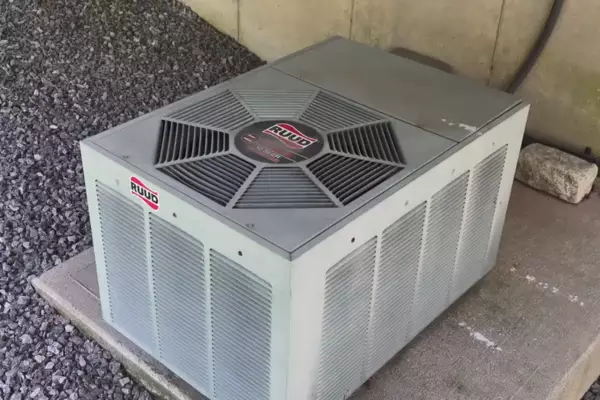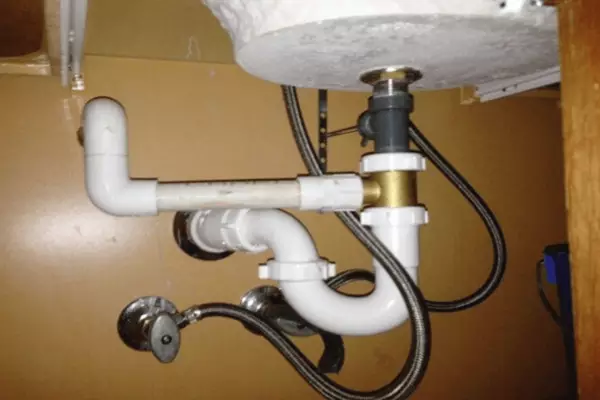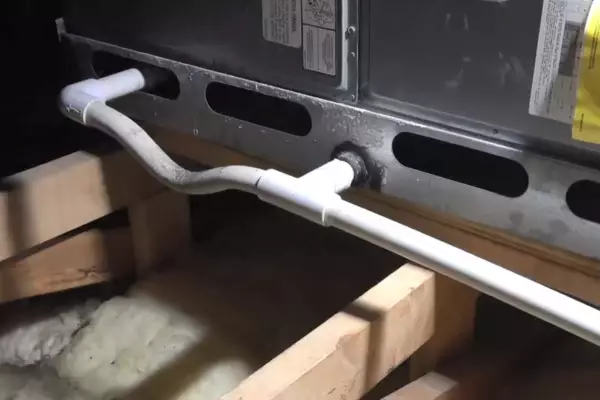An often overlooked yet crucial component of your air conditioning (AC) system is the drain line. It performs the vital function of draining away the condensation produced during the cooling process. The role of the drain line becomes more pronounced when you understand its connection to your plumbing system.
When your AC unit operates, it cools and dehumidifies the air. The resulting condensation needs an exit route – that’s where your AC drain line comes in. It’s designed to connect directly to your plumbing system, enabling efficient water disposal.
A poorly maintained drain line can lead to various problems. These issues can range from a simple clog to significant water damage, affecting your home’s infrastructure and overall air quality.
Contents
Structure of AC Drain Line
The AC drain line is an integral part of your air conditioning unit’s setup. It is typically constructed from PVC (polyvinyl chloride) pipe, which is chosen for its strength, resistance to corrosion, and affordability.
The configuration begins at the condensate drip pan, a shallow, usually rectangular container found just underneath your indoor air handler. This pan collects the moisture that forms on the evaporator coil of the AC unit during the cooling process.
From this pan, a pipe leads away the accumulated water. This pipe, known as the AC drain line, typically runs across the length of your house, often tucked away behind walls or above ceilings for aesthetic reasons. It finally discharges the condensate either outside your home or into your home’s plumbing system.
It’s important to note that most AC units have a secondary drain line as a backup. This secondary line is typically placed above the primary drain line and serves as a safety measure in case the primary line becomes clogged.

Function of AC Drain Line
Your AC unit performs two crucial functions – cooling your home’s air and dehumidifying it. It’s the second function that brings the AC drain line into play.
As your AC unit cools your home, it also removes moisture from the air. This dehumidification process produces condensate, which drips down from the evaporator coil into the condensate pan.
The AC drain line then comes into play. It’s a conduit for this water, channeling it from the condensate pan to an appropriate discharge location. This prevents water from accumulating within the system or overflowing into your home, which could cause water damage.
How AC Drain Line Connects to Plumbing
The endpoint of the AC drain line varies depending on the specific setup of your home. Some drain lines are directed towards the outdoors, where they discharge the condensate harmlessly onto the ground.
However, in many homes, especially those where an outdoor discharge might be impractical, the AC drain line connects directly to the plumbing system. This connection is often made to a utility sink, a floor drain, or directly into a sewer pipe.
This setup ensures that the condensate is effectively removed from your AC system and your home, without you having to manually empty a bucket or pan. However, it’s crucial that the connection adheres to local building codes and is performed by a licensed professional to prevent any potential issues, such as sewage backups or cross-contamination.
Tips for AC Drain Maintenance
Taking care of your AC drain line can save you from costly repairs and unnecessary headaches. Here are a few maintenance tips that can help keep your AC drain line in top shape:
Routine AC Drain Line Inspection
Regular inspections are the first line of defense when it comes to preventing AC drain line issues. It’s recommended to inspect the line at least twice a year, usually during the spring and fall.
During these inspections, you should check for any signs of clogging or leakage. Signs of a clogged drain line could include slow draining water or water backup in the condensate pan. Leaks, on the other hand, might show as water stains or damp patches along the path of the drain line.

Proper AC Drain Line Cleaning
An important step in maintaining your AC drain line is keeping it clean. Over time, the line can accumulate dust, dirt, and particularly algae, which thrives in the moist, dark environment inside the line.
Here’s a simple step-by-step guide on how you can clean your AC drain line:
- Turn off your AC system for safety.
- Locate the drain line access point, often a T-shaped vent with a cap located on the drain line.
- Remove the cap and inspect for any visible blockage.
- If the line isn’t clogged, you can proceed with cleaning by pouring a mixture of warm water and mild soap, or vinegar, down the drain.
- If there is a clog, you can try to clear it with a long, flexible brush designed for drain cleaning.
- Once the line is clear, replace the cap and turn the AC back on.
Remember, if the clog is stubborn or the line is heavily soiled, it might be best to call in a professional to ensure the line is thoroughly cleaned without causing any damage.
Importance of Professional AC Drain Service
While routine inspections and basic cleaning can be done by most homeowners, it’s recommended to have a professional AC drain service at least once a year. Professionals have the necessary tools and expertise to provide a thorough cleaning and inspection of your AC drain line.
A professional service includes a complete flush of the drain line to remove any stubborn clogs, checks for any potential leaks, and even an inspection of the condensate pan for any damage. The professional might also install an algaecide tablet in the drain pan to prevent algae growth, which is a common cause of clogs.
Common AC Drain Line Issues
Identifying common AC drain line problems is a vital aspect of maintenance. Quick identification and resolution of these issues can prevent expensive repairs down the line.
Clogged AC Drain Line
A common problem faced by many homeowners is a clogged AC drain line. Algae growth, dust accumulation, or mold can lead to blockages. Signs of a clogged drain line include water leaks around the AC unit and reduced cooling performance.
AC Drain Line Leaks
Leaks can develop in your AC drain line due to age, wear and tear, or physical damage. Regular inspections can help identify leaks early, preventing water damage to your home.
AC Drain Line Disconnection
Sometimes, the AC drain line can become disconnected due to physical impact or loosening over time. This can result in water leakage and damage to your home.

AC Drain Line Solutions
Methods to Clear AC Drain Line
Clearing a clogged AC drain line can be as simple as using a wet/dry vacuum on the drain line outlet. If the clog is stubborn, a more aggressive approach may be necessary, involving specific tools or chemical treatments.
Repairing AC Drain Line Leaks
Small leaks can be fixed using a patching material designed for PVC pipes. However, if the damage is significant, replacing the affected section of the pipe may be necessary.
AC Drain Line Reconnection Techniques
Reconnecting a disconnected drain line involves ensuring a secure fit between the drain line and the fitting. Sometimes, a replacement fitting may be required to achieve a secure connection.
AC Drain Line Connection Codes and Regulations
Building codes and regulations play a significant role when it comes to AC drain lines, especially those connected to a home’s plumbing. Noncompliance with these codes can lead to fines, penalties, and even the requirement to redo the entire setup.
Several essential factors are covered by building codes:
Proper P-Trap Installation
A P-trap, a U-shaped pipe, is required where the AC drain line connects to the sewer line. It works by trapping a small amount of water, which acts as a barrier preventing sewer gases from entering the home.
Air Gap Requirement
An air gap, a physical separation between the outlet of the AC drain line and the sewer line, is required to prevent cross-contamination. This gap prevents any backward flow from the sewer line into the AC system.
Secondary Drain Line
Most building codes require a secondary drain line as a backup if the primary line gets clogged. It’s often installed above windows or doorways to indicate a clog in the primary line by dripping water.
Each locality may have additional or specific codes regarding AC drain line installations. It’s important to hire a licensed professional familiar with your local regulations to ensure compliance when installing or servicing your AC drain line.
AC Drain Line and Indoor Air Quality
AC Drain Line’s Role in Air Quality
The AC drain line plays a pivotal role in maintaining indoor air quality. By efficiently disposing of the moisture produced during the cooling process, it helps prevent the growth of mold and bacteria inside the AC unit and your home.
Impacts of AC Drain Issues on Health
Blocked or malfunctioning AC drain lines can lead to moisture buildup, promoting mold and bacteria growth. These microorganisms can affect the air quality, potentially leading to health problems like allergies and respiratory issues.
Importance of AC Drain Maintenance for Air Quality
Regular maintenance of your AC drain line is essential for maintaining good air quality in your home. By preventing clogs and leaks, it ensures that your AC unit can effectively dehumidify the air, keeping your home comfortable and healthy.
Frequently Asked Questions
How often should the AC drain line be cleaned?
It’s recommended to clean your AC drain line at least once a year. However, if your AC unit runs constantly or you live in a high-humidity area, more frequent cleaning might be necessary.
Can I connect my AC drain line to the plumbing system myself?
While it’s possible for a homeowner with substantial DIY experience and knowledge of local building codes to connect an AC drain line to the plumbing system, it’s generally not recommended. Mistakes can lead to costly damages or code violations. Always hire a professional to handle such tasks.
What causes an AC drain line to clog?
The most common cause of AC drain line clogs is the buildup of dust, dirt, and algae. These materials can accumulate in the drain line over time, eventually causing a blockage.
How do I know if my AC drain line is clogged?
Signs of a clogged AC drain line include water leaks around the AC unit, a musty smell in your home, and reduced cooling performance of your AC system.
Conclusion
The importance of a properly maintained AC drain line cannot be overstated. It ensures efficient operation of your AC system, protects your home’s infrastructure, and promotes healthier indoor air quality.
Proper maintenance requires a combination of routine inspections, cleaning, and professional servicing. This approach helps spot potential problems early, preventing costly repairs and keeping your AC system in top shape.
At the end of the day, a well-maintained AC drain line equates to a smoothly functioning AC system, contributing to a comfortable and healthy home environment.
